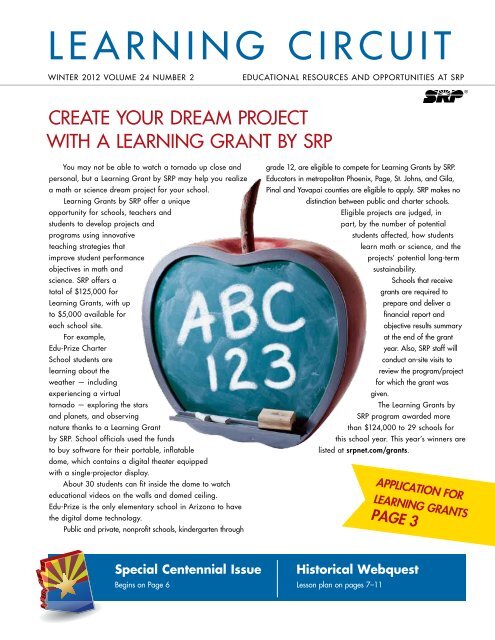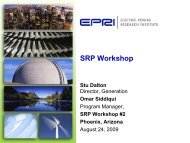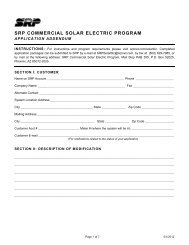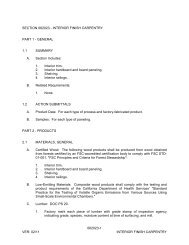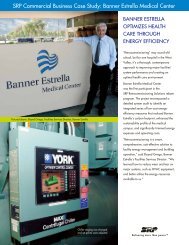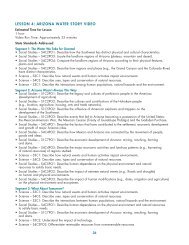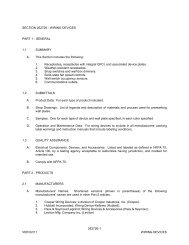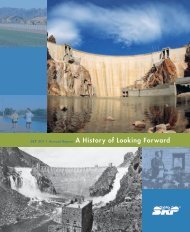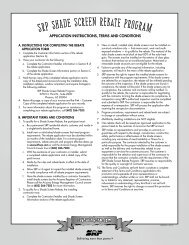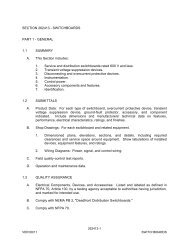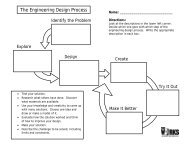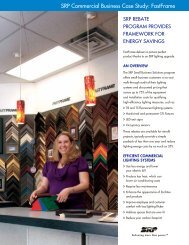Winter 2012 - Salt River Project
Winter 2012 - Salt River Project
Winter 2012 - Salt River Project
You also want an ePaper? Increase the reach of your titles
YUMPU automatically turns print PDFs into web optimized ePapers that Google loves.
HAPPENINGSSRP and partners invite you to the followingevents and educational opportunitiesCome see SRP at the following events available toeducators this spring and summer.Remember to check the calendar of professionaldevelopment workshops offered by our community partners:the Center for Teacher Succes centerforteachersuccess.org;and Arizona <strong>Project</strong> WET, cals.arizona.edu/arizonawet.• Saturday–Tuesday,Feb. 11–14 — ArizonaCentennial Best FestCelebration: Arizona BestFest offers a full calendar ofArizona centennial signatureevents and projectsthat celebrate Arizona’s 100 years of statehood atthe three territorial capitals. For details, visitaz100years.org/events/signature-events.• Saturday, Feb. 25 — Sid theScience Kid Visits Arizona Falls:The Public Broadcasting System’sSid the Science Kid tours ArizonaFalls at 56th Street and IndianSchool Road in a collaborativeventure with SRP. The PBS showtackles children’s questions about basic scientificprinciples and why things work the way they do. Seeazpbs.org for more details.Applications for June programs are available atcenterforteachersuccess.org. The deadline toapply is 4 p.m. March 30. Programs are availableto teachers in Gila, Maricopa, Pinal and Yavapaicounties as well as the cities of Page and St. Johns.Both programs are free but limited in class size.• Tuesday–Friday, June 12–15 — TeachingInquiry-Based Science Institute: Explore the 5E Modelfor Inquiry through the lens of children’s literature andcreate an instructional plan or product to take back toyour classroom.Specially selected resources from the National ScienceTeachers Association, related literature and a stipendwill be part of the package. The four-day instituteabout how to engage students in science educationis a collaborative effort involving SRP, Arizona StateUniversity’s Mary Lou Fulton Teachers College andthe Center for Teacher Success. The institute is held atASU Polytechnic (see below).• Tuesday–Friday, June 19–22(grades 7–12); Tuesday–Friday,June 26–29 (grades 3–6) —Global Climate Change inthe Southwest: An Academyfor Educators: Investigatethe basics of climate changeand its implications for the desert Southwest. Receiveclassroom-ready resources and create an instructionalplan or product to use in your classroom. (Grade 6teachers part of a middle school team with grades7 or 8 should apply for the grades 7–12 academy.)Stipends are provided upon completion. The academyis held in Tempe (see below).• Tuesday–Wednesday,July 10–11 — Verde <strong>River</strong>Institute, Camp Verde: DetailsTBD; check the Arizona <strong>Project</strong>WET website,cals.arizona.edu/arizonawet.4
TRAINING SCHEDULEADD TO YOUR RESOURCE ARSENAL;REGISTER FOR AN SRP IN-SERVICESRP in-service educator workshops for <strong>2012</strong> cover avariety of energy- and water-related topics. In addition toour regular schedule, workshops and in-services may bearranged throughout the school year. Please call AlisonSmith, (602) 236-2484, or email educate@srpnet.com toarrange campus-based in-services.To register, visit srpnet.com/education/secure/workshopsignup.aspx. An email confirmation with detailswill be sent to participants as each workshop nears. SRPneeds at least 10 participants to hold a workshop.Program: Celebrating Arizona’sCentennial — The Arizona Water StoryDate: Feb. 4Time: 9 a.m.–noon(3 continuing educationunit [CEU] hours)Location: SRP PERA Club, 1 E.Continental Drive, TempeProgram: All About Energy! Electricityand Magnetism (morning)Date: Feb. 11Time: 9 a.m.–noon (3 CEUs)Location: SRP PERA Club, 1 E.Continental Drive, TempeProgram: All About Energy! PoweringOur Future/Renewable Energy(afternoon)Date: Feb. 11Time: 12:30–3:30 p.m. (3 CEUs)Location: SRP PERA Club, 1 E.Continental Drive, TempeProgram: Water ChemistryDate: March 17Time: 9 a.m.–3 p.m. (6 CEUs)Location: SRP PERA Club, 1 E.Continental Drive, TempeProgram: Sustainability in theClassroom! (includes Powering OurFuture/Renewable Energy)Date: April 7Time: 9 a.m.–3 p.m. (6 CEUs)Location: SRP PERA Club, 1 E.Continental Drive, TempeQuestions? Please emaileducate@srpnet.com or call(602) 236-2484. Schedule informationis subject to change.DISCOVER OUR WATER HERITAGESRP offers several classroom resources to learn about Arizona’s water heritage.• When you visit our Celebrating Water in Arizona website at srpnet.com/education/celebratewater/index.aspx, you’ll find separate units for grades 3–5 and grades 6–8. Unitsfeature a digital storybook about Theodore Roosevelt Dam, instructions for making you ownhydroelectric generator and other inventive activities. Materials are grade-appropriate andcorrelated to Arizona state standards in social studies, science, math and language arts. Clickon the icon for the grade-appropriate module to explore the available resources.• Debuting last fall was an updated version of the Arizona Water Story, located at srpnet.com/education/azwaterstory.aspx. The Arizona Water Story provides Arizona fourth-grade teachers with a comprehensive water education unitincorporating social studies and science concepts. While designed for use in grades 4–6, it’s a great resource forfourth-grade teachers who need a supplement to the study of Arizona as a state or an additional physical scienceunit about natural resources. Geography, history, science, math and art have been integrated in such a way to helpstudents develop specific skills, such as critical thinking, organizing data, predicting, mapping and graphing.5
WEBQUEST LESSON PLANTheodore Roosevelt Dam WebQuestand Research Report WritingEstimated TimeWebQuest, 60 minutes; report, three to five daysdepending on writing time neededStandards TaughtWriting Strand 1, all concepts: writing processWriting Strand 1, all concepts: writing elementsState Standards for Grades 6–8Standards AddressedRS3C1PO2/PO4/PO5: reading informational textOBJECTIVES• Students will be able to synthesize information fromvarious factual Internet sources.• Students will be able to analyze the historicalsignificance of Theodore Roosevelt Dam constructionand write a research report about the event.VOCABULARY• Water reclamation: the process of collecting and savingwater from the natural environment for human use• Drainage area: a land area that drains to aparticular body of water (for example, when rain orsnow falls, the runoff drains to a river or lake)You Will Need ...Materials• Computers with Internetaccess (one per student orone per pair)• Printouts of websites visitedduring the TheodoreRoosevelt Dam WebQuestPROCEDURESActivity 1.1: Theodore Roosevelt Dam WebQuest1. Distribute Theodore Roosevelt DamWebQuest worksheets.2. If necessary, preview vocabulary that may be difficultfor students. Key vocabulary terms are listed abovefor your convenience. You may also choose to do theWebQuest as a class.3. Organize students into groups of two or three, and givestudents access to a computer to complete the WebQuest.Students will answer questions on the worksheet as theyvisit the sites listed.Activity 1.2: Writing a Research Report1. Preparation: Give students the opportunity to reflect onthe facts they learned about Roosevelt Dam constructionand list key details on a graphic organizer.2. Allow students to work through the writing process,providing feedback when needed.3. Science connection: Use this opportunity to talkto your students about the water cycle, naturalresources, costs and benefits of human modificationsto the environment, and other science and socialscience topics.EVALUATION• Student WebQuest worksheet• Assess students’ writing for facts and appropriatereport and writing elements7
WEBQUEST LESSON PLANAnswer KeyMission No. 11. Hohokam; answers will vary for second question2. Revitalized and used them for irrigation3. A storage dam4. National Reclamation Act; answers will vary forsecond question5. Apache; Native Americans; to bring supplies andmaterials to the Roosevelt Dam site6. Growth in the <strong>Salt</strong> <strong>River</strong> Valley; Seal of theState of Arizona7. Mines; City of Phoenix8. Theodore Roosevelt pressed a button to allow therelease of water from the reservoir into the river below.9. The location of the dam was ideal for storing water.Mission No. 21. A reliable source of water2. Theodore Roosevelt3. 19024. Theodore Roosevelt DamMission No. 31. Drawings will vary2. About 76 miles northeast of Phoenix and 30 milesnorthwest of Globe3. Concrete gravity arch dam4. 357 feet5. 5,830 square miles6. Answers will vary10
WEBQUEST LESSON PLANStudent Worksheet Activity 1.2Research Report About Theodore Roosevelt DamName:Directions: Use this graphic organizer to help plan your research report about Theodore Roosevelt Dam. You may need tovisit the library or do additional Internet searches for more information about Roosevelt Dam. Also, feel free to go back to thewebsites from the WebQuest activities to refresh your memory. Organize facts from your notes into the boxes below.Life before the dam was built:Building Roosevelt Dam:Roosevelt Dam is dedicated:Life with Roosevelt Dam (how the dam has had an impact on Arizona and life for people in the <strong>Salt</strong> <strong>River</strong> Valley):11
CLASSROOM ACTIVITY: PIONEERINGHISTORICAL CLASSROOM ACTIVITY:PIONEERING IN THE SALT RIVER VALLEYThe people who settled the <strong>Salt</strong> <strong>River</strong> Valley, foundingPhoenix and its surrounding communities, had to beresourceful. The American West from 1865–1900 offered ahardscrabble existence — it wasn’t for the faint of heart.The following classroom activities are intendedfor fourth-grade students and address state-mandatedcompetencies (1 SS E4, 3 SS E2/E7, and 4 SE 4). Theactivities also will give students a notion of what pioneerliving entailed.The wagons settlers used to transport their worldlypossessions could hold a limited amount. There were nosuch things as moving van lines, and hauling items on atrain was reserved for the rich. Difficult choices had to bemade as to what to bring.The following exercises illustrate those choices.THE WAGON TRIP GAME:• Draw a 4- by 10-foot rectangle on the floor orground, or outline one with string.• Have four to six students get inside the rectangle“wagon.” Imagine having all your possessions alsopacked into this area.• Discuss the length of the trip — oftenseveral months.ooooooWhat would you take?What would you leave behind?How would you decide on what to take?• Rope is a very valuable item on such a trip. Thinkup as many uses as possible.• A bandana is another handy item. Think up asmany uses as possible.• Most children had no toys. Instead, they playedgames. Name some games they could play. Howelse could they pretend?• In the evenings, after the day’s work, families oftensang together. Some of the songs from that periodinclude Oh, Susanna, When Johnny Comes MarchingHome, Beautiful Dreamer, Carry Me Back to OldVirginny and Clementine. Do you know the words? Canyou think of other popular songs of this era?12
CLASSROOM ACTIVITY: THEN AND NOWTHEN AND NOW: HOW LIFE HAS CHANGED IN 100 YEARSHow did people do things 100 years ago? How has lifechanged since then?One way to understand the differences betweentoday’s world and the way things were is to review the listof activities below. Middle school students can peruse this“inventory,” then compare their answers with those of theirparents and grandparents. Students are also encouraged tocompare notes with an older relative or neighbor.Bonus idea: Students can “adopt” a retirementcommunity or assisted-living facility and visit residents ona weekly or monthly basis. As an icebreaker, students andretirement community residents can compare answers onthis list. Residents can recount to students what it was like togrow up in the first half of the 20th century.Have you ever: You Parents Grandparentsu Milked a cow? ______ ______ ______u Ridden a horse? ______ ______ ______u Hitched a team to a wagon? ______ ______ ______u Churned butter? ______ ______ ______u Washed clothes with a tub and washboard? ______ ______ ______u Made ice cream by hand? ______ ______ ______u Written with a fountain pen? ______ ______ ______u Used block ice in an icebox? ______ ______ ______u Used a wind-up phonograph? ______ ______ ______u Grown your own vegetables? ______ ______ ______u Played with paper dolls? ______ ______ ______u Used a treadle sewing machine? ______ ______ ______u Ground your own flour? ______ ______ ______u Made bread from scratch? ______ ______ ______u Sent or received a telegram? ______ ______ ______u Lived in an adobe house? ______ ______ ______u Made a quilt? ______ ______ ______u Ridden a trolley? ______ ______ ______u Made yarn from wool? ______ ______ ______u Listened to a radio show? ______ ______ ______u Played hopscotch? ______ ______ ______u Ridden a train? ______ ______ ______u Cooked on a wood stove? ______ ______ ______u Played marbles or jacks? ______ ______ ______Did your parents or older relatives/neighbors suggest any other activities from days gone by?What current activities do you think your grandchildren will find quaint or archaic?13
CLASSROOM ACTIVITY: HOHOKAMCLASSROOM ACTIVITY: WHERETHE HOHOKAM LIVEDThe following classroom exercise, intendedfor third- and fourth-graders, focuses on earlyArizona history and map-reading skills.Phoenix and its surroundingcommunities are based in the <strong>Salt</strong> <strong>River</strong>Valley. Historically, the main land use inthis area has been agricultural.As early as A.D. 100, a nativeAmerican people called the Ho-hoogamsettled in the <strong>Salt</strong> <strong>River</strong> Valley; Ho-hoogamtranslates to “those who have gone.” Weknow these people as the Hohokam.As their culture developed, theHohokam used stone tools to dig a networkof canals that carried water from the <strong>Salt</strong><strong>River</strong> to their villages and vegetable andcotton fields.The canal system had a series ofmain canals, each of which supported asystem of laterals and distribution canalsthat brought water to crops and the largervillages. All large villages were supportedby a canal. Archaeologists estimate theHohokam may have built as many as 850miles of canals and laterals in the Valley.Eventually, the Hohokam beganmoving to the Gila <strong>River</strong>; archaeologistssay settlement patterns began changingin late 1300. By 1450, for reasons thatstill are unclear, the Hohokam abandonedmuch of the <strong>Salt</strong> <strong>River</strong> Valley.However, the Hohokam left behindtheir extensive network of canals as ablueprint for success for future inhabitants.Modern canal routes, which engineersaligned using precision surveyinginstruments, are surprisingly similar tothose dug with stone tools by the Valley’sprehistoric forebears.Use the map on the facing page for thefollowing map-skills exercises.1. Write N, E, S and W on the map toidentify the four points of the compass.2. Locate the NE corner of the map. Whatdoes NE stand for? Where is the SWcorner? NW? SE?3. Count down five blocks from the NEcorner of the map to locate the <strong>Salt</strong> <strong>River</strong>.4. Which way does the river flow?Describe the river flow usingcompass directions.5. Identify the general compass direction ofall the Hohokam canals. Why is this so?6. Count the number of locations alongthe river where one of the prehistoriccanals begins. Count both north andsouth sides. How many are there?7. What symbols tell you there was agroup of dwellings or buildings? Howmany Hohokam villages do you count?8. What modern city names can youidentify on the map? Which moderncity covers the most Hohokam villages?9. Can you find the square mile whereyour house is located? Were thereany Hohokam canals or villagesnearby? Where was the closest canalto your school?10. Locate the Arizona Canal on themap (farthest north). This was nota Hohokam canal, but it is still animportant part of the SRP system. Whydidn’t the Hohokam have a canalthere? Who dug it?14
SCIENCE AND TECHNOLOGYFESTIVAL OFFERS A GLIMPSE OF A STRANGEAND WONDERFUL FUTUReThe Arizona SciTech Festival is an invitation to peopleof all ages to discover the strange and wonderful world ofscience and technology. The festival will showcaseArizona as a national leader in science,technology and innovation througha series of hands-on activities andworkshops, dialogues and debates,exhibitions, concerts, guidedwalks and tours statewideduring February <strong>2012</strong>.Spearheaded bythe Arizona TechnologyCouncil Foundation inpartnership with ArizonaState University and theArizona Science Center,the Arizona SciTechFestival is a grassrootscollaboration of morethan 200 organizationsin industry, academia, thearts and the community.It is geared to excite andinform Arizonans of allages about the discoveriesthat will drive the state fornext 100 years. SRP is amongthe main sponsors.The Arizona SciTech Festivalactually is a variety of events. Of note:• There will be large celebrationsof science and technology thatestablish science as part oflocal culture.• Events range in size, place and format (show, tourand interaction).• Festivals serve as venues to interface scienceprofessionals with the public.• Local festivals and events will play out over severaldays or weeks, attracting widespread public attentionand involvement.For details about events, seeazscitechfest.org/events.“The Arizona SciTech Festivalis an innovative strategy to helpaddress the challenges our statefaces related to the environment,energy and health that requiressolutions from a workforceinformed by knowledgeof the underlying science,engineering and technology,said Dr. Jeremy Babendure,festival director andbiomedical scientist.He said the nation’scompetitiveness andeconomic strength in theglobal market dependson a workforce trainedand educated inSTEM-related fields.“The festival is designed tohelp the public better understandthe strong relationship between thestate’s current outstanding researchand technology and the immensepotential it offers for Arizona’s future,”said Steven G. Zylstra, President and CEO ofthe Arizona Technology Council.For more details about the Arizona SciTechFestival, visit azscitechfest.org/azscitechfest.16
HONORSTOP TEACHERS HONORED FOR MAKINGA DIFFERENCE FOR STUDENTSKristie Martorelli of Thompson Ranch Elementary Schoolin El Mirage was selected as the <strong>2012</strong> Arizona EducationalFoundation (AEF) Teacher of the Year. Martorelli is areading interventionist for grades K–3 at Thompson Ranch inthe Dysart Unified School District.She was joined by four “ambassadors” and fivesemifinalists honored by the AEF at a luncheon in November atthe Camelback Inn. More than 500 Arizona educators, electedofficials and business leaders attended the event, marking 29years that the AEF has recognized top state educators.The AEF’s Teacher of the Year and four Ambassadorsfor Excellence will serve as spokespeople for their profession,advocating for excellence in the classroom by makingpresentations statewide to educational, civic, governmentaland professional organizations.Martorelli has been teaching in the Dysart Unified SchoolDistrict for 11 years, including Thompson Ranch — recognizedby the AEF as an A+ School of Excellence. She received herbachelor’s in elementary education with an ESL endorsementfrom Arizona State University, and her reading specialistendorsement and master’s in educational administration andsupervision from the University of Phoenix. She anticipatescompleting her master’s in curriculum and instruction through theUniversity of Phoenix in May.The Ambassadors for Excellence are:• Tara Bernier, fourth grade, Queen CreekElementary School, an AEF A+ School of Excellencewinner in the Queen Creek Unified School District.Bernier is in her 12th year of teaching.• Sofia Gamez, kindergarten, Francisco Vasquez deCoronado Elementary School, Nogales UnifiedSchool District. She is in her 10th year of teaching,all at Coronado Elementary.• Cindy Pino, ninth- and 11th-grade AP English, PerryHigh School (Gilbert), Chandler Unified School District.Pino has been a teacher for 30 years, the past fourwithin the Chandler Unified School District.• Debbie Young, third grade, Richardson ElementarySchool (Tucson), an AEF A+ School of ExcellencePhoto courtesy of the Arizona Educational FoundationThe Arizona Educational Foundation honorees are, fromleft, Debbie Young, Cindy Pino, Kristie Martorelli (Teacher ofthe Year), Sofia Gamez and Tara Bernier.winner in the Flowing Wells Unified SchoolDistrict. Young is a national board-certified teacher,generalist/middle childhood.The presenting sponsor of this year’s AEF Teacher of theYear program was Wells Fargo in collaboration with SRP,The Arizona Republic, Intel Corp., Blue Cross Blue Shield ofArizona, Boeing Corp., Midstate Energy and Valley SchoolsManagement Group.The annual Teacher of the Year program is the premierevent of the AEF, a statewide organization that promotesand awards the exceptional educational efforts in Arizona’spublic schools. To learn more, visit azedfoundation.org.18
HONORSRODEL EXEMPLARY TEACHERS ‘PAY IT FORWARD’Eight educators in Maricopa County were among the 13individuals statewide selected to “pay it forward” by servingas counselors and guides to promising teachers.The Scottsdale-based Rodel Foundation of Arizonaannually selects “Exemplary Teachers” from throughoutArizona to mentor promising student teachers. Eachexemplary teacher receives $5,000 and agrees to mentorabout six student teachers over the next three years. Theidea is to provide soon-to-be teachers with role models whoare succeeding in the classroom.The knowledge that exemplary teachers haveaccumulated is what the Rodel Foundation wants to makesure is passed along, especially in high-needs schools,which can place greater demands on teachers. Throughpartnerships with Arizona universities and support ofbusinesses such as SRP, about 120 exemplary teachers inhigh-needs schools have mentored more than 500 studentteachers since the program began in 2003.• Francesca Davis is a four-year special educationteacher who works with fourth- througheighth-grade students at Discovery School, nearMaryland and 79th avenues, in the GlendaleElementary School District.• Theresa Graves teaches fifth grade at the AvondaleElementary School District’s Eliseo C. Felix School,near Van Buren Street and Central Avenue inGoodyear. She has spent 24 years in education ina variety of positions, including teacher’s assistant,school secretary, reading specialist and teacher.• Sal Mancilla teaches sixth grade at Ralph WaldoEmerson Elementary School, near Seventh Streetand McDowell Road, in the Phoenix ElementaryDistrict. The 15-year educator spent four yearsteaching third grade and 11 years teachingsixth grade.• Jasmine Muniz teaches sixth grade at BalszElementary School, near Loop 202 and 44th Streetin Phoenix, which is part of the Balsz ElementarySchool District. The nine-year educator has taughtkindergarten, fourth grade and sixth grade, andbeen a pullout teacher for students learning English.• Leticia Rodriguez-Davis teaches fifth grade atHartford Sylvia Encinas Elementary School, nearAlma School and Ray roads, in the ChandlerUnified School District. She has taught fourththrough sixth grades, been a K–8 special educationresource teacher and taught English languagedevelopment.• Daniele Prusinski teaches first grade atManzanita Elementary School, near 39th andNorthern avenues in Phoenix, which is part of theWashington Elementary School District.• Scott Thompson teaches sixth grade at GranadaEast School, near Campbell and 27th avenues inPhoenix, which is part of the Alhambra ElementarySchool District. The 10-year educator has taughtfifth and sixth grades.• Jason VanderKamp teaches fourth and fifth gradeat the Tempe Elementary School District’s FrankElementary School, near Interstate 10 and BaselineRoad in Guadalupe. The seven-year educator alsospent one year as a fourth-fifth grade teacher.For more information about the Rodel ExemplaryTeacher program, visit rodelfoundationaz.org.19
LEARNING CIRCUITSRPCommunity Outreach PAB332P.O. Box 52025Phoenix, AZ 85072-2025ABOUT USSRP is an electricity andraw-water provider, offering freesupport to public, private, charterand home school educators inour water and electric serviceterritories (metropolitan Phoenixand Pinal and Gila counties) aswell as Yavapai County, Page andSt. Johns.MAILING ADDRESSLearning CircuitSRPCommunity Outreach PAB332P.O. Box 52025Phoenix, AZ 85072-2025FOR MORE INFORMATIONContact SRP Community Outreach,(602) 236-2484, or emaileducate@srpnet.com.ADDRESSING ADDRESSESPlease help us continue to serve you and your peers in the educationcommunity as efficiently as possible. We want to keep the Learning Circuit mailinglist accurate and updated — eliminate duplicate names, correct spelling errorsand include all pertinent information.Your response is appreciated. If we need to update your mailing information,please ensure the following elements are included and correct.• Teacher’s title (Mr., Ms., Mrs., Dr., Sr., Fr., Rev., etc.)• Teacher’s first name• Teacher’s last name• Teaching grade (include all that apply)• Subject taught• School’s name• School’s address• City, state and ZIP code• Phone number• Fax number• Principal’s title (Mr., Ms., Mrs., Dr., Sr., Fr., Rev., etc.)• Principal’s nameTo make a change or add someone to the Learning Circuitmailing list, send an email to educate@srpnet.com.Printed on recycled paper.11-1415-01


